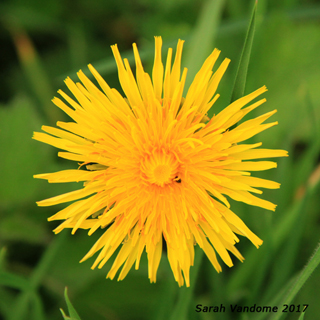 Dandelions: a bane to gardeners the world over, wherever they raise their vivid yellow heads. And yet, could we learn to love them… just a little bit? Sarah Vandome explores their value to wildlife – and to us.
Dandelions: a bane to gardeners the world over, wherever they raise their vivid yellow heads. And yet, could we learn to love them… just a little bit? Sarah Vandome explores their value to wildlife – and to us.
As a gardener I must confess I do harbour some irritation towards this bane of my flower borders, despite the cheery yellow flower heads that take the place of the sunny daffodils already running to seed. However, I have learned to tolerate dandelions just a little in the lawn, where the cutting height of the mower can be adjusted for just few weeks of spring, until later in the season. The reward for such saintly tolerance? Clouds of visiting pollinators, and a sign that the food web has been enriched and widened just that little bit more.
The dandelion (Taraxacum officiniale) is a member of the Asteraceae (or daisy) family. The composite flower head is made up of individual, single-petalled florets. The name Dandelion is derived from the French – dent de lion (lion’s tooth) – descriptive of the jagged single petal of each floret. Each floret has its own pollen-coated stamens and nectary, and an ovary where a single seed will form, whether or not pollination takes place. Such a reproductive strategy may benefit the species, by rendering it both genetically adaptive in the face of variable, even extreme habitats, as well as capitilising on the availability of optimal conditions.
 The peak dandelion flowering period is March to May, coinciding with the emergence of key pollinators upon which we humans rely later in the year to polinate many of our valuable food plants. Many bee species, hoverflies, butterflies snd beetles visit dandelions, gorging on the nectar and protein-rich pollen. And the abundance of well fed insects themselves form food supplies to larger, predatory species.
The peak dandelion flowering period is March to May, coinciding with the emergence of key pollinators upon which we humans rely later in the year to polinate many of our valuable food plants. Many bee species, hoverflies, butterflies snd beetles visit dandelions, gorging on the nectar and protein-rich pollen. And the abundance of well fed insects themselves form food supplies to larger, predatory species.
Later in the year, birds such as Goldfinches and House sparrows will eat the ripe seed from the seed head globes – or “clocks” – before the breeze blows any remaining seed away, each one on its own little perfect dispersal parachute.
Dandelions are considered an important food plant to humans too, and have a notable commercial value. The roots are dried, roasted, and ground into a caffeine-free coffee substitute, commercially available form health stores. Young dandelion leaves have a sharp flavour and make a welcome addition to leafy salads. The flower heads can be brewed into country wine. And of course, anyone with a pet rabbit or tortoise will tell you that dandelions are a welcome part of these animals’ varied diet, being rich in important vitamins and minerals.
So before you run out of patience and weed-and-feed your lawn with chemical cocktails, let the dandelions cheer you on your way into summer with their sunny flowers, knowing how many lives their existence benefits. I’m still removing them from the flower borders though.
Event reminder – The Wild Roseland Photographic Competition and Exhibition is nearly upon us!
29th and 30th April, Portscatho Memorial Hall, 10am – 4pm.
Enter this free competition for a chance to win some great prizes! Submit up to 4 photos of Roseland scenes, celebrating its wild natural beauty. Adults and children can enter. Rules are as follows:
- You must be a Roseland or Tregony resident
- Photos can be in colour or mono-colour, taken with camera, tablet or phone
- Digital adjustment is allowed
- Images downloaded from the internet are not allowed
- Printed images should be flush mounted or mounted on board.
- Images must not be larger than A3
Please provide your name, contact details, age if under 18, and a description of where and when the photo was taken on the back of the print. Submit entries in an envelope, between March 25th and April 22nd, at one of these collection points:
- St Mawes: Fudge & Moore
- Portscatho: Harbour Gallery
- Veryan: Ellerkey Gallery
- Ruan High Lanes: Da Bara Café
- Tregony: Just Perfection Hairdressers or Tregony Gallery
Photos will be judged and on public display at Portscatho Memorial Hall on 29th and 30th April, as part of the Roseland Festival.
Edited by: Sarah E Vandome
Contributors:
David Hall, Sarah Vandome.
Edited by Sarah Vandome.
References and links
Enjoy more Roseland wildlife and landscapes – visit Sarah Vandome’s Heart of Roseland Facebook feature:
https://www.facebook.com/HeartOfRoseland?ref=hl
Wild Roseland is a group of volunteers who care passionately about looking after the nature and landscape of the Roseland peninsula in south Cornwall. Through a number of initiatives and projects, the aim is to inspire and enhance the conservation of this special place for all.



